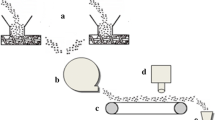Abstract
An approach for the efficient development of near-infrared (NIR) methods for blend analysis using simulated real blending conditions is described. Spectra used to calculate a model were collected from small volume pharmaceutical blends in a die subject to well-controlled forces. Blend end-point detection by NIR spectroscopy is widely used. Strategic deployment of analytical technology is critical to companies seeking to utilize quality by design (QbD) and process analytical technology (PAT) concepts. However, pilot and commercial scale experiments using near-infrared spectroscopy (NIRS) are often limited due to resources. Specifically, limitations to the quantity of active pharmaceutical ingredients (APIs) available during development stage can dissuade early PAT method development. Such experiments are often necessary due to substantial differences between NIR data collected from small-scale (laboratory) blend systems and larger scale equipment. In the present work, data collected from small samples of pharmaceutical powders placed in an Instron testing station under carefully controlled forces matched conditions of the same powders in a blender. Use of this strategy for development of NIR-based blend end-point methods requires minimal quantities of pharmaceutical powders. Principal component analysis (PCA), two-dimensional (2D) correlation spectroscopy analysis, and Hotelling’s T2 ellipse results demonstrated that NIR spectra obtained in the small die matched NIR spectra in a blender when forces to the die were carefully applied. This strategy has the potential to significantly reduce the cost of development of NIR methods for blending.













Similar content being viewed by others
References
FDA. Guidance for Industry, PAT-A Frame-work for Innovative Pharmaceutical Development, Manufacturing, and Quality Assurance. Pharmaceutical CGMPs. 2004.
FDA/ICH. Guidance for Industry, Q8 Pharmaceutical Development. 2006.
FDA/ICH. Guidance for Industry, Q9 Quality Risk Management. 2006.
FDA/ICH. Guidance for Industry. Q10 Pharmaceutical Quality System, 2007.
Burns DA, Ciurczak EW. Handbook of near-infrared analysis. 2nd ed. New York: Marcel Dekker, Inc; 2001. p. 814.
Wargo DJ, Drennen JK. Near-infrared spectroscopic characterization of pharmaceutical powder blends. J Pharm Biomed Anal. 1996;14:1415–23.
Sekulic SS, Ward HW, Brannegan DR, Stanley ED, Evans CL, Sciavolino ST, et al. On-line monitoring of powder blend homogeneity by near-infrared spectroscopy. Anal Chem. 1996;68:509–13.
Momose W, Imai K, Yokota S, Yonemochi E, Terada K. Process analytical technology applied for end-point detection of pharmaceutical blending by combining two calibration-free methods: simultaneously monitoring specific near-infrared peak intensity and moving die standard deviation. Powder Technol. 2011;210:122–31.
Shi Z, Cogdill RP, Short SM, Anderson CA. Process characterization of powder blending by near-infrared spectroscopy: blend end-points and beyond. J Pharm Biomed Anal. 2008;47:738–45.
Wu H, Tawakkul M, White M, Khan MA. Quality-by-design (QbD): an integrated multivariate approach for the component quantification in powder blends. Int J Pharm. 2009;372:39–48.
Li W, Worosila GD. Quantitation of active pharmaceutical ingredients and excipients in powder blends using designed multivariate calibration models by near-infrared spectroscopy. Int J Pharm. 2005;295:213–19.
Berntsson O, Danielsson LG, Lagerholm B, Folestad S. Quantitative in-line monitoring of powder blending by near infrared reflection spectroscopy. Powder Technol. 2002;123:185–93.
Sulub Y, Wabuyele B, Gargiulo P, Pazdan J, Cheney J, Berry J, et al. Real-time on-line blend uniformity monitoring using near-infrared reflectance spectrometry: a noninvasive off-line calibration approach. J Pharm Biomed Anal. 2009;49:48–54.
FDA. FDA Guidance for Industry: immediate release solid dosage forms: scale-up and post approval changes (SUPAC-IR). 1995.
Segtnan VH, Sasic S, Isaksson T, Ozaki Y. Studies on the structure of water using two-dimensional near-infrared correlation spectroscopy and principal component analysis. Anal Chem. 2001;73:3153–61.
Kramer K, Ebel S. Application of NIR reflectance spectroscopy for the identification of pharmaceutical excipients. Anal Chim Acta. 2000;420:155–61.
Blanco M, Peguero A. Analysis of pharmaceuticals by NIR spectroscopy without a reference method. Trends Anal Chem. 2010;29:1127–36.
Noda I. Generalized two-dimensional correlation method applicable to infrared, raman, and other types of spectroscopy. Appl Spectrosc. 1993;47:1329–36.
Noda I, Ozaki Y. Two-dimensional correlation spectroscopy. Chichester: Willey; 2004.
Noda I. Progress in two-dimensional (2D) collation spectroscopy. J Mol Spectrosc. 2006;799:2–15.
Noda I, Liu Y, Ozaki Y, Czarnecki MA. Two-dimensional Fourier transform near-infrared correlation spectroscopy studies of temperature-dependent spectral variations of oleyl alcohol. J Phys Chem. 1995;99:3068–73.
Sasic S, Muszynski A, Ozaki Y. A new possibility of the generalized two-dimensional correlation spectroscopy. 2. Sample-sample and wavenumber-wavenumber correlations of temperature dependent near-infrared spectra of oleic acid in the pure liquid state. J Phys Chem A. 2000;104:6388–94.
Ren Y, Matsushita A, Matsukawa K, Inoue H, Minami Y, Noda I, et al. Two-dimensional fourier-transform raman and near-infrared correlation spectroscopy studies of poly- (methyl methacrylate) blends 2. Partially miscible blends of poly (methyl methacrylate) and poly(4-vinylphenol). Vib Spectrosc. 2000;23:207–18.
Matsushita A, Ren Y, Matsukawa K, Inoue H, Minami Y, Noda I, et al. Two-dimensional fourier-transform raman and near-infrared correlation spectroscopy studies of poly (methyl methacrylate) blends 1. Immiscible blends of poly (methyl methacrylate) and atactic polystyrene. Vib Spectrosc. 2000;24:171–80.
Segtnan VH, Sasic S, Isaksson T, Ozaki Y. Studies on the structure of water using two-dimensional near-infrared correlation spectroscopy and principal component analysis. Anal Chem. 2001;73:3153–61.
Wang C, Xiang B, Zhang W. Application of two-dimensional near-infrared (2d-NIR) correlation spectroscopy to the discrimination of three species of Dendrobium. J Chemom. 2009;23:463–70.
Shinzawa H, Awa K, Noda I, Ozaki Y. Pressure-induced variation of cellulose tablet studied by two-dimensional (2D) near-infrared (NIR) correlation spectroscopy in conjunction with projection pretreatment. Vib Spectrosc. 2013;65:28–35.
Katz JM, Roopwani R, Buckner IS. A material-sparing method for assessment of powder deformation characteristics using data collected during a single compression-decompression cycle. J Pharm Sci. 2013;102:3687–93.
Kano M, Tanaka S, Hasebe S, Hashimoto I, Ohno H. Independent components for fault detection. AIChE J. 2003;49:969–76.
Acknowledgments
Authors would like to thank Astellas Pharma Inc. for their financial supports for this project and JDSU for the use of the compact NIR spectrometer. Authors also would like to thank Dr. I. S. Buckner for his input on the use of the Instron testing station.
Author information
Authors and Affiliations
Corresponding author
Rights and permissions
About this article
Cite this article
Momose, W., Katz, J.M., Drennen, J.K. et al. Development of NIR Methods for Blend Analysis Using Small Quantities of Materials. J Pharm Innov 10, 36–46 (2015). https://doi.org/10.1007/s12247-014-9204-3
Published:
Issue Date:
DOI: https://doi.org/10.1007/s12247-014-9204-3




